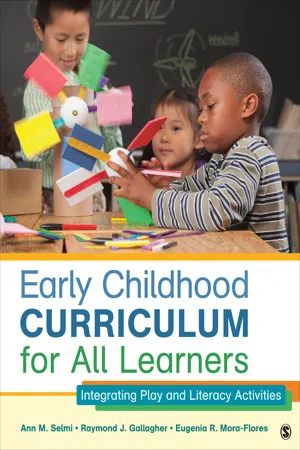
eBook - ePub
Early Childhood Curriculum for All Learners
Integrating Play and Literacy Activities
- 504 pages
- English
- ePUB (mobile friendly)
- Available on iOS & Android
eBook - ePub
Early Childhood Curriculum for All Learners
Integrating Play and Literacy Activities
About this book
Early Childhood Curriculum for All Learners: Integrating Play and Literacy Activities is designed to teach early childhood professionals about the latest research on play and early literacy and then to show them practical methods for adapting this research to everyday classroom practices that will encourage the development of learning skills. The authors link solid, play-based research to specific developmentally appropriate practices. By combining these two areas, the text demonstrates that academic learning and play activities are highly compatible, and that children can and do develop academic skills through play. In addition, the text focuses on socio-dramatic play, a recently acknowledged, essential aspect of child-initiated play interactions. It provides specific strategies that link these interactive behaviors with the early academic skills needed for the initial primary grades. Implementation of the information presented in this book will enable children to experience a richer transition into primary education classrooms.
Frequently asked questions
Yes, you can cancel anytime from the Subscription tab in your account settings on the Perlego website. Your subscription will stay active until the end of your current billing period. Learn how to cancel your subscription.
No, books cannot be downloaded as external files, such as PDFs, for use outside of Perlego. However, you can download books within the Perlego app for offline reading on mobile or tablet. Learn more here.
Perlego offers two plans: Essential and Complete
- Essential is ideal for learners and professionals who enjoy exploring a wide range of subjects. Access the Essential Library with 800,000+ trusted titles and best-sellers across business, personal growth, and the humanities. Includes unlimited reading time and Standard Read Aloud voice.
- Complete: Perfect for advanced learners and researchers needing full, unrestricted access. Unlock 1.4M+ books across hundreds of subjects, including academic and specialized titles. The Complete Plan also includes advanced features like Premium Read Aloud and Research Assistant.
We are an online textbook subscription service, where you can get access to an entire online library for less than the price of a single book per month. With over 1 million books across 1000+ topics, we’ve got you covered! Learn more here.
Look out for the read-aloud symbol on your next book to see if you can listen to it. The read-aloud tool reads text aloud for you, highlighting the text as it is being read. You can pause it, speed it up and slow it down. Learn more here.
Yes! You can use the Perlego app on both iOS or Android devices to read anytime, anywhere — even offline. Perfect for commutes or when you’re on the go.
Please note we cannot support devices running on iOS 13 and Android 7 or earlier. Learn more about using the app.
Please note we cannot support devices running on iOS 13 and Android 7 or earlier. Learn more about using the app.
Yes, you can access Early Childhood Curriculum for All Learners by Ann M. Selmi,Raymond J. Gallagher,Eugenia R. Mora-Flores in PDF and/or ePUB format, as well as other popular books in Education & Early Childhood Education. We have over one million books available in our catalogue for you to explore.
Information
PART I Working With Young Learners
Research has shown that early language skills allow children to learn from others
and provide the foundation for successful reading experiences. Young children
learn language by actively participating in events. Typically, children expand
their skills to a higher level when they engage in play activities with their
peers. This book examines how play activities can guide children to enhance
their high-quality language and literacy skills.
Part
I of the book presents information on using developmentally appropriate
play activities with young children to enhance early learning. Language and
literacy skills can develop when children explore their environment and
collaboratively produce pretend peer-play narratives. These narratives enhance
language and literacy skills and influence children’s future social and academic
success.
Adults must have a comprehensive understanding of the similarities between play,
language, and literacy development. They must know how to create contexts in
which all children are self-motivated to enhance their literacy abilities and
that create a strong foundation for further successful academic learning
throughout their school years. Chapter 1 explains the need to modify classroom
practices so that children are engaged in developmentally appropriate practices
that motivate them to expand their learning. Chapter 2 addresses
how play activities enhance children’s learning, while Chapter 3
discusses the impact that symbolic representations have on the development of
early language and literacy learning. Chapter 4 then
focuses on how the development of play supports language and literacy
enhancement. Finally, Chapter 5 centers on the idea that all adults,
professionals, and family members must work together so children can maximize
their learning of skills during the early education years. By understanding the
relationships between play, language, and literacy, adults can create activities
that motivate all children to achieve their highest level of learning.
1 The Need for Developmentally Appropriate Practices
The Poison Syrup
Two boys walk over to the kitchen play area in a preschool classroom and start looking into the cupboards. One boy pulls out an empty paper towel roll from a cupboard and then quickly turns to the other boy saying, “Look! We found the poison syrup! Now we have to get it out of here.”
© iStockphoto.com/mzoroyan
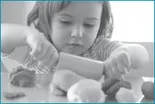
The second boy, who is standing still and staring at the roll, responds, “We’re right! It was here!” As he is talking, he quickly picks up a plastic shopping basket with items in it, shakes them out on to the floor, and says, “Here’s the steel container to hold it. It says it here.” He points to the print on the outside of the basket. Then he steadily holds out the basket with both hands towards the boy with the roll and says, “Put the poison in here so we can take it downstairs to our truck. We don’t want it to spill.”
The boy with the roll gently places it in the basket and then says, “Wait! We need to mark it ‘dangerous.’” He picks up a pen that is in the kitchen play area and prints letter-like figures on the roll while the other boy steadily holds the basket. Then, each boy takes hold of the sides of the basket and pretends to carefully walk down some stairs, while commenting on the need to be careful and not spill.
Events similar to the ones described in this scenario appear in classrooms for young children, community centers, and homes of young children. Play events have always been considered both developmentally appropriate and a cornerstone of a young child’s learning. As children engage in play they share their creativity through verbal and nonverbal language and tangible representations of their thinking. The interaction of children as they play provides a safe environment for acquiring both conversational and academic language. Through play children learn how to engage in oral discourse. They exchange their understanding and use of vocabulary, syntax, and cultural knowledge. Additionally, they also learn how to problem-solve and negotiate ideas. These rich, developmentally appropriate learning opportunities are seamless for children through play. As children develop, play allows them to escape from their present worlds and travel to fictitious worlds that are created by the intertwining of their personal knowledge, plans, and dreams. As this book will demonstrate, many of the skills that children develop during pretend play activities provide the foundation for the skills needed when they are enrolled in school and participate in common core activities. These skills include solving problems, making predictions, analyzing information, and negotiating ideas.
This chapter analyzes how adults can design developmentally appropriate practices that implement academic standards-based learning outcomes that meet the needs of all children and build both social and academic language. Additionally, it describes the diverse population that is currently enrolled in today’s early childhood classrooms, and examines the benefits and challenges that they provide. Knowing how to integrate early learning standards and play activities will assist educators in responding both to current classroom challenges and when encountering concerns that can arise from administrators, parents, and politicians who are encouraging more structured learning changes.
As you read the chapter, consider the following:
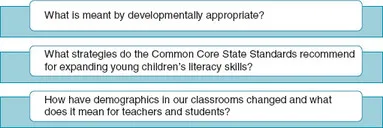
Developmentally Appropriate Practices
Within the past two decades formal early learning standards have been designed and many parents, administrators, and politicians have proposed that formal academic activities replace the traditional play activities of young children (Hirsh-Pasek, Golinkoff, Berk, & Singer, 2009). Many educators are alarmed about the impact on children’s overall learning with these types of curriculum changes that decrease play opportunities and child-centered activities where children’s interactions focus on meaningful learning activities that the child is self-motivated to accomplish. Instead, those activities are being replaced with inappropriate adult-directed instruction focusing on activities where adults lead children through specific steps of a learning activity.
Play has typically been thought to be a valuable experience for young children’s learning and development.
Michael Greenberg/Photodisc/Thinkstock
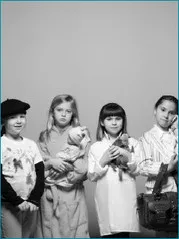
Educational researchers have produced a comprehensive collection of studies that clearly demonstrates a direct relationship between play activities and early academic skill development—that is, language and literacy skills, math and science skills, and social and self-regulatory skills, which are summarized below (for a complete review, see Fisher, Hirsh-Pasek, Golinkoff, Singer, & Berk, 2011).
The National Association for the Education of Young Children (NAEYC) is the nation’s premier organization of early childhood professionals. It establishes research-based standards for programs and professionals, provides resources to improve the quality of early education programs, assists families in learning how to identify high-quality educational programs, and enhances professionals’ knowledge through professional development activities such as workshops, seminars, and conferences.
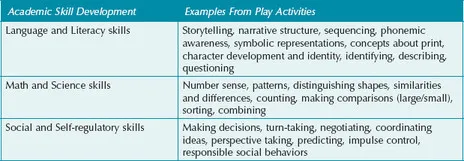
In 2009 the NAEYC published a Position Statement that offers a framework for creating best practices for the development and learning of children birth through age 8. This report is grounded in current research findings on child development and learning and expressly identifies the following needs: (1) to reduce learning gaps in achievement, (2) to improve the connection between preschool education and elementary education, and (3) to identify teacher knowledge and decision making as vital to educational effectiveness. This statement, which addresses concerns similar to the ones addressed in this chapter, complements other NAEYC position statements (NAEYC, 2005; NAEYC & NAECS/SDE, 2002, 2003) by outlining practices for use in today’s eclectic classrooms to promote optimal learning and development.
Today’s diverse classrooms promote ideal learning opportunities for all children.
© iStockphoto.com/CEFutcher
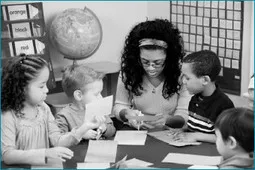
For almost 20 years, the NAEYC has advocated two fundamental commitments: (1) that excellence and equality must be provided for the education of all children, and (2) that teachers must have a core understanding of how children learn and develop physically, socially, emotionally, linguistically, and cognitively. Specifically, the NAEYC endorses the concept of Developmentally Appropriate Practices (DAP), which is the belief that all teaching practices should be appropriate to children’s ages and developmental status, attuned to them as unique individuals, and responsive to the social and cultural contexts in which they live (Copple & Bredekamp, 2009).
Likewise, the National Head Start Association (NHSA) is an organization that advocates on behalf of two federally funded early education programs. One program is the Early Start Program, which promotes the school readiness for children birth to 2 years old from low-income families by enhancing their cognitive, social, and emotional development. Another program is the Head Start Program, which promotes the school readiness of children ages 3 to 5 years old from low-income families by also enhancing their cognitive, social, and emotional development. Similar to NAEYC, the mission of NHSA is to combat poverty in the United States by advocating for educational equality for all children and for early education professionals who are capable of providing high-quality, comprehensive programs in the areas of education, health, social services, and parent-community. This book fully supports the commitments of NAEYC and NHSA. However, as discussed later in this chapter, unfortunately the following trends exist (Child Trends Data Bank, 2012):
- Only 55% of 3- to 6-year-olds who were not in kindergarten attended early education programs in 2007
- Children from low-income families are less likely than children in more affluent families to attend early education programs
- Children of mothers who work are more likely than children whose mothers do not work to attend early education programs
The NAEYC (2009) proposes the following four evidence-based findings that provide the framework for efforts to ...
Table of contents
- Cover
- Half Title
- Acknowledgements
- Title Page
- Copyright Page
- Brief Contents
- Detailed Contents
- Preface
- PART I Working With Young Learners
- 1 The Need for Developmentally Appropriate Practices
- 2 Learning Through Play
- 3 Play and Pretending
- 4 Language and Literacy Development
- 5 Collaborating With Families and Professionals
- PART II Planning and Designing a Classroom for Learning Through Play
- 6 Planning for Effective Learning
- 7 Designing High-Quality Centers for Learning
- 8 Strategies for Guiding Play and Producing High-Quality Learning Activities
- 9 Observing and Assessing to Promote Learning
- PART III Integrating Play Activities Across the Curriculum
- 10 Integrating Literacy Skills Into the Play Centers
- 11 Integrating Play Activities in the Science Centers
- 12 Integrating Play Activities in the Mathematics Centers
- 13 Integrating Play Activities in the Social Studies and Book Centers
- 14 Integrating Play Activities in the Creative Arts Centers
- References
- Glossary
- Index
- About the Authors
- Publisher Note